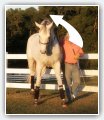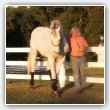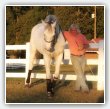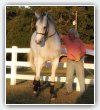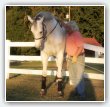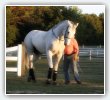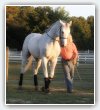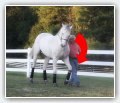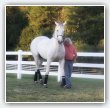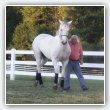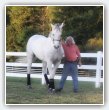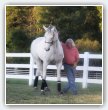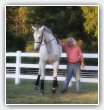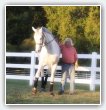Shoulder In proper and inverted rotation
Educate your Eye
Shoulder in executed in hand with correct and inverted rotation.
Even if the concept of rotation associated with lateral bending has been clearly explained in 1999 with Jean Marie Denoix’s magisterial work, the concept remains foreign to judging standards and most training techniques. The concept is important to know; proper or inverted rotation is often the difference between good and poor performance as well as soundness or limbs injuries and back issues. In practically all the rehabilitations that we have completed, the subject of inverted rotation was part of the problem.
The first picture series shows right shoulder in and then right turn, executed in hand with correct rotation. The direction of the rotation is illustrated by a white arrow. At the second frame, Chazot is putting some weight on the bit while lowering the neck. The gesture increases the load on the forelegs. Chazot is then almost associating right lateral bending and inverted rotation. Fortunately, His mind was on the correct coordination and the fault lasts only one frame. He corrects himself at the next frame.
Correct Shoulder In
Right laterial bending coupled with correct rotation
Incorrect Shoulder In
Right laterial bending coupled with inverted rotation
The second picture series shows right shoulder in executed in hand and coupled with inverted rotation. The direction of the rotation is illustrated with a red arrow. The good thing with chazot is that he never does anything half way. He is trying to put some weight on the bit and the rotation become worse each step. Right shoulder in and therfore right laterial bending coupled with inverted rotation clearly shift the weight on the horse's left shoulder.
In fact the series presented first as the good rotation is the continuation of this bad series. Chazot recovered his balance and was able to come back with the correct coordination between lateral bending and proper rotation.
One may ask how inverted rotation does feel. The feeling is easy to recreate. One just has to halt the horse on the rail keeping the horse’ vertebral column straight and bending the horse neck laterally toward the inside of the ring, at an angle of about 90°. As the horse bends the neck, the rider will be shifted toward the outside of the horse’s back and on the outside seat bone. This is the feeling of inverted rotation.
Jean Luc Cornille Copyright©2011
Sign up for our free newsletter



 twitter
twitter facebook
facebook google
google stumbleupon
stumbleupon yahoo
yahoo linkedin
linkedin blogger
blogger